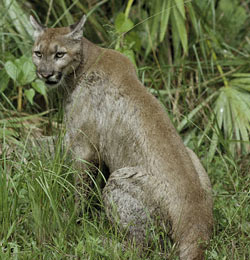If you sense the presence of a large cat while walking in the jungles of Panama, the elusive mountain lion (puma concolor) is probably not the first thing that comes to mind. Its secretive behavior has been a double edged sword, helping it survive the targeted predator hunts of the 19th and 20th centuries but also rendering it far less famous than its distant relative, the jaguar. Despite its relative anonymity, the mountain lion is the only other mammal which has demonstrated the same versatility as humans in conquering the American continents. Evidence of its wide range is reflected in the myriad number of names it has collected over the centuries. The mountain lion that overlooks the Canadian Rockies is the same species as the panther that wanders the jungles of Florida and the puma that scales the Andes of Peru.

Once a member of a guild of large cats which included the American Lion, the American cheetah and the saber-toothed tiger, mountain lions are now the largest wild felid remaining in North America and the second largest in South America. Genetic evidence suggests that North American mountain lions went extinct along with all the other large cats at the end of the Pleistocene 10000 years ago and that North America was reconquered by mountain lions from the south. Thus, the presence of mountain lions in the United States and Canada today speaks to the importance of maintaining linkages such as the Central American Corridor between North and South America.
In North America, male mountain lions weigh around 55-65 kg and females weigh about 40-45 kg. Mountain lions of the tropics tend to be smaller than their temperate counterparts, mostly likely due to environmental influences and possibly because of competition with the sympatric jaguars. Mountain lions are impressive ambush predators that can take down prey as large as a moose and as small as a mouse. Most mountain lions, except females and their kittens, live solitary lives and on vast territories.
In Panama, mountain lions are currently protected from hunting are are not considered endangered by the IUCN. However, the mountain lion’s need for large areas of intact habitat, slow breeding rate, and occasional taste for livestock sometimes brings it into conflict with neighboring human populations. Additionally, large predators, due to their low densities and reliance on prey species, can often be quickly wiped out by people if they are deemed to be a threat. For these reasons, ecoReserve will promote environmental education programs in the Mamoni Valley that will help local residents learn to safely live alongside large cats such as jaguars and mountain lions. By protecting an important habitat corridor, ecoReserve will help maintain the linkage that allows mountain lions to move between the two continents.

I like the helpful information you provide in your articles. I will bookmark your blog and check again here regularly. I am quite sure I will learn plenty of new stuff right here! Best of luck for the next!